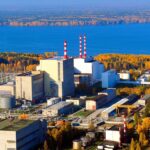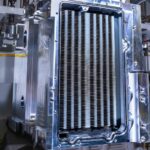
A nuclear power plant is a thermal power station; the heat source is a nuclear reactor. It is common in all regular thermal power stations; the heat is used to produce steam which initiatives a steam turbine associated to an electric generator and which produces electricity.
To produce energy high amount of coal and petroleum are used. But there is no possibility to meet the energy requirement. So in case of those resources we need to used other alternate resources for the process. The energy can be progressive by the nuclear fission of materials like plutonium (Pu), uranium (U) has released with new sources of power of great importance. Due to fission the heat is produced. To generate steam from the water they use uranium (U) and plutonium (Pu) mainly they are used for the running of the turbo generator. Compare with the high grade coal one kilogram of uranium produces much energy. This illustrations that nuclear energy can be effectively employed for generating low cost energy in plenty as required by the increasing and automating population of future.
Some more favorable factors to follow by the nuclear energy:
- Mainly the hydroelectric power storage is typically based upon the type of the monsoons.
- For transportation oil is required
- For generation of power high amount of fertilizers and petro chemical is not use.
- Coal is the main source for the power generation but transportation and they are available in rare areas
- For transportation it requires high amount of cost and investment is also high
- Nuclear power is mainly independent of geographical factor but the requirement should be reasonably good supply of water.
- Fuel carrying set-ups and larger storing services are not required
- Nuclear power plant is a unsoiled basis of power which does not infect the air if dangerous hazards are successfully banned
- Large amount of energy is unconfined with consumption of only a minor quantity of fuel.
Nuclear Fission:
According to the nuclear physics and chemistry nuclear fission is known as a radioactive decay method in which the nucleus of atoms is split into small parts. The process produces photons and neutrons. From this it releases high amount of energy straight by the energetic principles of radioactive decay.
Inside the metal reactor the fuel is known as Uranium (U). The Uranium must be exist in the form of , and
From above three is more unbalanced. When a neutron is seized by a nucleus of an atom then it splits unequally into two equal pieces, in which 2.5 neutrons are unconstrained. Large amount of energy must be produce that is nearly 200 million electron volts MeV. It is known as fission process. The neutrons are processed the moving neutrons and it creates fission with other nuclei of so chain reaction takes place. If the fission must be takes place in high level then it produces high amount of heat.
Control rods:
The main aim of the control rods is to limit the split of fuel atoms. The rods are made up of the materials which absorbs neutrons. The reactor must is turned on for rods are pulled out. The rods are made of cadmium or boron.


